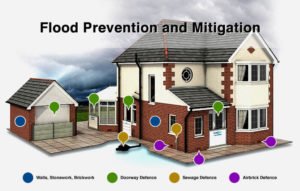Up and down the UK, there are millions of properties; homes and businesses that are deemed to be susceptible to flooding. The government are continuously investing time, money and expertise in the prevention of flooding and flood damage. However, there are still a number of things you can do to ensure that your business and/ or home are as protected as can be from flooding and the damage it can cause.
Unlike potential risks to properties like rising damp, energy inefficiency and a lack of comfort, all of which can be solved with the fairly easy addition of things like double glazing; protecting against flooding is often more of a long term investment and plan and such protection can be undertaken in conjunction with other measures you may apply to your property for the winter (read more about protecting your home in the winter).

How Does Flood Water Enter a Property?
Part of the reason why flooding has the potential to cause quite so much damage and lasting consequences is because it can enter your property via a number of channels, all of which have the potential to cause thousands or even tens of thousands of pounds worth of damage. Furthermore, it is more than just heavy rainfall damaging your roof to gain access:
Doors and Access Points – Every property and business premises will naturally have a number of ‘natural’ access points. This includes things like windows, doors, delivery access points and even cat flaps. All of these are potential points of water access and therefore should be properly secured and blocked up if there is any risk of flooding.
Drains and Pipes – Whilst having sufficient irrigation and drainage is essential to helping negate the risk of flooding, too much pressure building up in the drains, pipes and other drainage facilities can cause the ‘back-up’ of water. This means that water can come up through the drains, pipes, sinks and even appliances like washing machines and dishwashers, causing flooding.
Gaps and Air Bricks – Exposed walls, constructed out of air bricks can be another route for flood water to enter your property and they should therefore be sufficiently covered and protected. All gaps in the floor or in the walls should be properly blocked up in preparation too.

Take a number of measures to reduce water entry
Limiting Water from Gaining Access to Your Property
There is no method that is 100% effective at keeping flood water out of your property. However, following the advice and recommendations of bodies like the Environmental Agency can go a long way in helping protect your property. Should flooding be forecast or if the area in which your property is in is deemed to be at risk of flooding, it is important that you seek advice from local authorities and the Environmental Agency.
It is also very important that businesses in areas that are at risk of flooding work together to make sure that the entire area, rather than just an individual business premises is as protected as possible. This will give all properties in the area the best chances of avoiding or at the very least, minimising the damage from flooding.
Flood Resistance
There are numerous measures that it is recommended are taken for all properties at risk of flooding in order to make them as ‘flood resistant’ as possible:
- Special covers for ventilation bricks
- Valves fitted to drains and drain-pipes to prevent backing-up of water
- Using filled sandbags to plug up doors and other vulnerable points
- Using plastic sheeting in conjunction with all flood resistance measures
Flood Resilience
Flood resilience means taking measures to ensure that should water enter your property, only minimal damage occurs. This is different to ‘flood resistance’ which refers to the measures you may take to stop water entering in the first place.
Flood resilience includes taking measures when floods are likely such as moving valuable items to higher ground, ensuring no electrical cables are low lying and lining the edges of rooms and all doors and internal access points with protective measures like sandbags or plastic sheeting.
Also, making sure that flooring materials for your property are things like tiles, ceramic flooring and solid wood instead of the likes of fitted carpets and rugs.
More Information:


